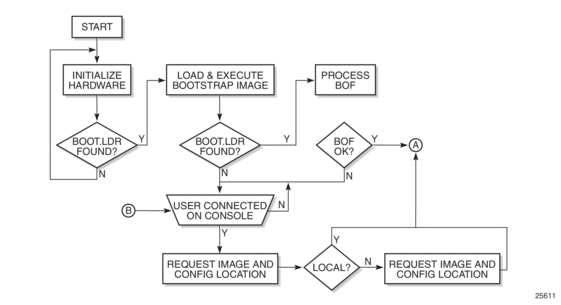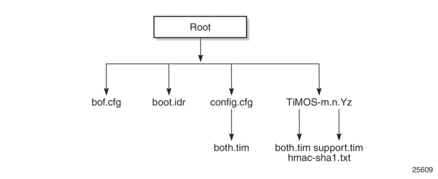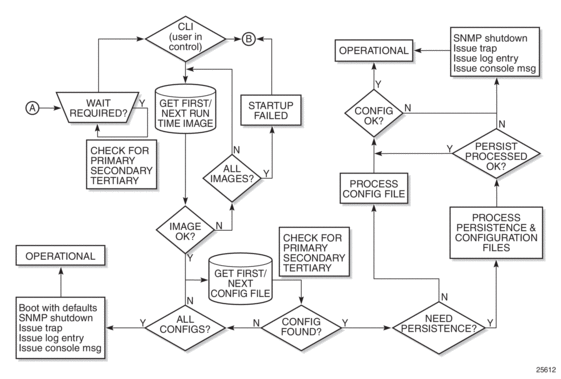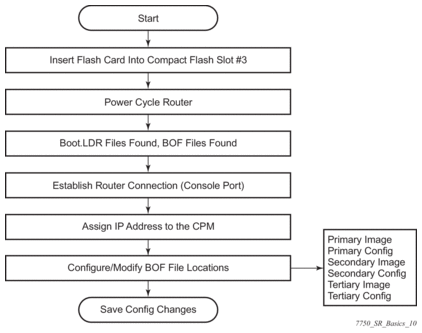4. Boot Options
4.1. System Initialization
The primary copy of SR OS software is located on a compact flash card. The removable media is shipped with each router and contains a copy of the OS image.
Note:
|
Starting a router begins with hardware initialization (a reset or power cycle). By default, the system searches Compact Flash Slot #3 (cf3) for the boot.ldr file (also known as the bootstrap file). The boot.ldr file is the image that reads and executes the system initialization commands configured in the boot option file (BOF). The default value to initially search for the boot.ldr file on cf3 cannot be modified.
The following is an example of a console display output when the boot.ldr file cannot be located on cf3.
When the bootstrap image is loaded, the BOF is read to obtain the location of the image and configuration files. The BOF must be located on the same compact flash drive as the boot.ldr file.
Figure 6 displays the system initialization sequence. In the figure, “A” refers to Figure 7, and “B” refers to the list of files on the compact flash.
Figure 6: System Initialization - Part 1

Figure 7 displays the compact flash directory structure and file names for the redundant chassis models.
Figure 7: Files on the Compact Flash

Files on compact flash are:
- bof.cfg — Boot option file
- boot.ldr — Bootstrap image
- config.cfg — Default configuration file
- TIMOS-m.n.Yz:m — Major release numbern — minor release numberY: A — Alpha releaseB — Beta releaseM — Maintenance releaseR — Released softwarez — Version number
- cpm.tim — CPM image file
- iom.tim — XCM/IOM image file
- support.tim — required data for SR OS .tim files
- hmac-sha1.txt (in FIPS-140-2 mode only)
| Note: XCM applies to the 7950 XRS only. |
Figure 8 displays the compact flash directory structure and file names for the 1-slot and 1-slot non-redundant models (the non-redundant models apply to the 7750 RS only).
Figure 8: Files on the Compact Flash (1-slot and 1-slot non-redundant)

Files on the compact flash (1-slot models) are:
- bof.cfg — Boot option file
- boot.ldr — Bootstrap image
- config.cfg — Default configuration file
- TIMOS-m.n.Yz:m — Major release numbern — Minor release number
- Y: A — Alpha release
- B — Beta release
- M — Maintenance release
- R — Released software
z — Version number- both.tim — CPM and IOM image file
- support.tim — required data for SR OS .tim files
- hmac-sha1.txt (in FIPS-140-2 mode only)
The 7750 SR includes a boot option for running the node in a FIPS-140-2 mode. This mode limits the use of cryptographic algorithms on the CPM to only those that are in accordance with the FIPS-140-2 certifications associated with the 7750 SR.
4.1.1. Configuration and Image Loading
When the system executes the boot.ldr file, the initialization parameters from the BOF are processed. Three locations can be configured for the system to search for the files that contains the runtime image. The locations can be local or remote. The first location searched is the primary image location. If not found, the secondary image location is searched, and lastly, the tertiary image location is searched.
If the BOF cannot be found or loaded, then the system enters a console message dialog session prompting the user to enter alternate file locations and file names.
The boot.ldr can be interrupted during the boot sequence by pressing any key on the CPM console port. The operator must then type sros and press ENTER within 30 seconds or the boot.ldr will continue trying to boot the system. This key sequence ensures that noise or misconfiguration does not inadvertently interrupt the boot sequence. If the operator types sros and presses ENTER within 30 seconds, they are brought to a console message dialog session prompting the user to enter file locations and other boot information.
When the runtime image is successfully loaded, control is passed from the bootstrap loader to the image. The runtime image attempts to locate the configuration file as configured in the BOF. Like the runtime image, three locations can be configured for the system to search for the configuration file. The locations can be local or remote. The first location searched is the primary configuration location. If not found, the secondary configuration location is searched, and lastly, the tertiary configuration location is searched. The configuration file includes chassis, card, MDA, and port configurations, as well as system, routing, and service configurations.
Figure 9 displays the boot sequence.
Figure 9: System Initialization - Part 2

The following displays an example of BOF output:
4.1.1.1. Persistence
Optionally, the BOF persist parameter can specify whether the system should preserve system indexes when a save command is executed. During a subsequent boot, the index file is read along with the configuration file. As a result, a number of system indexes are preserved between reboots, including the interface index, LSP IDs, path IDs, etc. If persistence is not required and the configuration file is successfully processed, then the system becomes operational. If persist is required, then a matching x.ndx file must be located and successfully processed before the system can become operational. Matching files (configuration and index files) must have the same filename prefix such as test123.cfg and test123.ndx and are created at the same time when a save command is executed. Note that the persistence option must be enabled to deploy the Network Management System (NMS). The default is off.
Traps, logs, and console messages are generated if problems occur and SNMP shuts down for all SNMP gets and sets, however, traps are issued.
4.1.1.2. Lawful Intercept
Lawful Intercept (LI) describes a process to intercept telecommunications by which law enforcement authorities can unobtrusively monitor voice and data communications to combat crime and terrorism with higher security standards of lawful intercept capabilities in accordance with local law and after following due process and receiving proper authorization from competent authorities. The interception capabilities are sought by various telecommunications providers.
As lawful interception is subject to national regulation, requirements vary from one country to another. -This implementation satisfies most national standard’s requirements. LI is configurable for all service types.
4.1.1.3. FIPS-140-2 Mode
The 7750 SR includes a configurable parameter in the bof.cfg file to make the node run in FIPS-140-2 mode. When the node boots in FIPS-140-2 mode, the following behaviors are enabled on the node:
- The node performs an HMAC-SHA1 integrity test on the software images .tim files.
- The node limits the use of encryption and authentication algorithms to only those allowed for the associated FIPS-140-2 certification of the 7750-SR.
- Cryptographic module startup tests are executed on the CPM when the node boots to ensure the associated approved FIPS-140-2 algorithms are operating correctly.
- Cryptographic module conditional tests are executed when required during normal operation of associated when using FIPS-140-2 approved algorithms.
- When configuring user-defined encryption or authentication keys, CLI will prompt for the key to be re-entered. If the re-entered key does not match the original, the CLI command will be canceled. This affects several protocols and applications.
To support FIPS-140-2, an HMAC-SHA-1 integrity check is performed to verify the integrity of the software images. The following file is included in the TIMOS-m.n.Yz software bundle containing the hmac-sha-1 signature:
- hmac-sha1.txt
During the loading of the cpm.tim or both.tim, a HMAC-SHA-1 check is performed to ensure that the calculated HMAC-SHA-1 of the loaded image matches that stored in the hmac-sha1.txt file.
The HMAC-SHA-1 check is performed on the data loaded from the .tim file. Note that when configuring the primary-image, secondary-image and tertiary-image, the hmac-sha1.txt file must exist in the same directory as the .tim files. If the load has been verified correctly from the HMAC-SHA-1 integrity check, the load continues to bootup as normal. If the load is not verified by the HMAC-SHA-1 integrity check, the image load will fail.
After the HMAC-SHA-1 integrity check passes, the nodes continues its normal bootup sequence including reading the config.cfg file and loading the configuration. The config.cfg file used to boot the node in FIPS-140-2 mode must not contain any configuration that is not supported in FIPS-140-2 mode. If such configuration is present in the config.cfg file when the node boots, the node will load the config.cfg file until the location of the offending configuration and then halt the configuration at that point. Upon a failure to load the config.cfg file, a failure message is printed on the console.
Enabling FIPS-140-2 restricts the ability to configure and use cryptographic algorithms and functions that are not FIPS approved. FIPS-140-2 impacts the ability to configure SSH, SNMP and certificates. Refer to the 7450 ESS, 7750 SR, and 7950 XRS System Management Guide for details of FIPS-140-2 related items.
In addition, signature algorithms of the following combinations only are approved for FIPS:
- FIPS-140 Approved - Digital Signature Standard (DSS)
- DSA
- RSA
- ECDSA
- FIPS-140 Approved - Secured Hash Standard (SHS)
- SHA-1
- SHA-224
- SHA-256
- SHA-384
- SHA-512
Any other combination is not supported in FIPS mode. Using other FIPS signature algorithms in certificates affecting IPSec can cause tunnels to fail. Restrictions to cryptographic algorithms are listed in the System Configuration Guide.
4.2. Initial System Startup Process Flow
Figure 10 displays the process start your system. Note that this example assumes that the boot loader and BOF image and configuration files are successfully located.
Figure 10: System Startup Flow

4.3. Configuration Notes
This section describes BOF configuration caveats.
- For router initialization, the compact flash card must be installed in the Compact Flash #3 slot.
- The loading sequence is based on the order in which it is placed in the configuration file. It is loaded as it is read in at boot time.